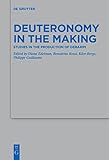Deuteronomy in the Making : Studies in the Production of Debarim / ed. by Diana Edelman, Kåre Berge, Philippe Guillaume, Benedetta Rossi.
Material type: TextSeries: Beihefte zur Zeitschrift für die alttestamentliche Wissenschaft ; 533Publisher: Berlin ; Boston : De Gruyter, [2021]Copyright date: ©2021Description: 1 online resource (X, 430 p.)Content type:
TextSeries: Beihefte zur Zeitschrift für die alttestamentliche Wissenschaft ; 533Publisher: Berlin ; Boston : De Gruyter, [2021]Copyright date: ©2021Description: 1 online resource (X, 430 p.)Content type: - 9783110713053
- 9783110713411
- 9783110713312
- 222.1506 23
- BS1275.52 .D484 2021
- BS1275.52 .D484 2021
- online - DeGruyter
- Issued also in print.
| Item type | Current library | Call number | URL | Status | Notes | Barcode | |
|---|---|---|---|---|---|---|---|
 eBook
eBook
|
Biblioteca "Angelicum" Pont. Univ. S.Tommaso d'Aquino Nuvola online | online - DeGruyter (Browse shelf(Opens below)) | Online access | Not for loan (Accesso limitato) | Accesso per gli utenti autorizzati / Access for authorized users | (dgr)9783110713312 |
Frontmatter -- Foreward -- Contents -- Introduction -- Part I: Case Studies Relating to the Production of Debarim -- From Where Did Deuteronomy Originate? -- Deuteronomy as the Instructions of Moses and Yhwh vs. a Framed Legal Code -- Cities in Deuteronomy: Imperial Ideology, Resilience, and the Imagination of Yahwistic Religion -- What Does Deuteronomy Centralize? -- Innovations of the Deuteronomic Law and the History of Its Composition -- Deuteronomy’s Māqôm before Deuteronomy -- Deuteronomy and the Older Royal Narrative: Some Core Questions -- Part II: Case Studies on Textual Units or Themes within Debarim -- Deuteronomic Law, Deuteronomic Narrative, or Exodus Narrative? The Multivalence and Multiformity of Deuteronomy 18:15–22 -- The War Laws in Deuteronomy -- Brothers in Deuteronomy: Zoom in on Lothar Perlitt’s Volk von Brüdern -- “Not by Bread Alone” (Deut 8:3): Elite Struggles over Cultic Prebends and Moses’s Torah in Deuteronomy -- The גר (Gēr) in Deuteronomy -- Authority, Prestige or Subversion? Jeremiah and the Law Code of Deuteronomy -- Ancient Citation Index -- Subject Index -- Modern Authors Index
restricted access online access with authorization star
http://purl.org/coar/access_right/c_16ec
A number of long-standing theories concerning the production of Deuteronomy are currently being revisited. This volume takes a fresh look at the theory that there was an independent legal collection comprising chs 12-26 that subsequently was set within one or two narrative frames to yield the book, with ongoing redactional changes. Each contributor has been asked to focus on how the “core” might have functioned as a stand-alone document or, if exploring a theme or motif, to take note of commonalities and differences within the “core” and “frames” that might shed light on the theory under review. Some of the articles also revisit the theory of a northern origin of the “core” of the book, while others challenge de Wette’s equation of Deuteronomy with the scroll found during temple repairs under Josiah. With Deuteronomic studies in a state of flux, this is a timely collection by a group of international scholars who use a range of methods and who, in varying degrees, work with or challenge older theories about the book’s origin and growth to approach the central focus from many angles. Readers will find multivalent evidence they can reflect over to decide where they stand on the issue of Deuteronomy as a framed legal “core.”
Issued also in print.
Mode of access: Internet via World Wide Web.
In English.
Description based on online resource; title from PDF title page (publisher's Web site, viewed 28. Feb 2023)


